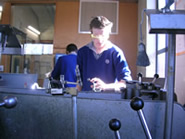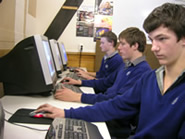
Virtual Lathe - Christchurch Boys' High School

Christchurch Boys' High School is a decile 10 school with 1,360 pupils – 78% Pakeha, 13% Asian, 7% Māori and 2% Pacific Island.
Hans Van Oyen is in his sixth year of teaching. Starting out as a fitter and turner, Hans worked as a sales engineer before moving into teaching. He taught at Linwood High School and Riccarton before arriving at Christchurch Boys'.
Hans was keen to use the virtual lathe to introduce use of a lathe in a safe environment. He hasn't yet tried it with the seniors but says it was "hugely appropriate” for the juniors. It was a good way for them to get a feel for what a lathe is all about, names of parts and what every part does. He also found it a good way to talk through the safety issues.
Two periods were allocated for the class although Hans says that, with hindsight, he would spend more time on the unit.
Brief


The class worked through theory sheets prior to using the computer, so that they had some understanding of the subject. Using the virtual lathe enabled them to do their work in a more active, visual way.
The virtual lathe was a harmless way for the boys to learn from their mistakes and from the teacher's perspective took away a lot of the stress factor of taking a large class of effectively children in an inherently dangerous environment.
Hans found that it smoothed out a lot of the wrinkles, making things easier to manage when the class (of 24) did get on to the lathe.
Another benefit was a reduction in broken tools, as well as a lot less time spent sharpening tools compared to other years.
Results

Student using a lathe

Students working with the Virtual Lathe program
The students loved working on it and Hans notes that it was good to have them sitting in an environment without the distractions of the workshop – "they were quietly absorbed”. He could tell from the whole atmosphere in the class that they were enjoying it, and many picked it up during a wet lunchtime. Hans says it gave the students a good head start and made his teaching a lot easier.
The students were asked to try and make something on the virtual lathe and then replicate it. Hans feels that he would develop this more next time. He did attempt this but most didn't achieve what he'd hoped, with many struggling, partly because of difficulty with the programme which kept locking and had to be rebooted each time. He says that the students were a little bit frustrated by this but it is not a major problem, rather one that can be overcome relatively easily.
Hans' reaction to working with the virtual lathe is that he would like to see it expanded into other skills, such as welding, or any machinery operated in the workshop.
If using this again Hans would expect his class to produce a particular piece of work as their 'certificate', on the understanding that once they could produce this on the virtual lathe he would let them move on to the machine.
At the conclusion of the work students said that using the virtual lathe prepared them for using the real thing. It brought home to them that the lathe is not something they can play around with and that they need to practice. They were also grateful that when they broke something in their virtual work they weren't faced with pieces flying out at them.